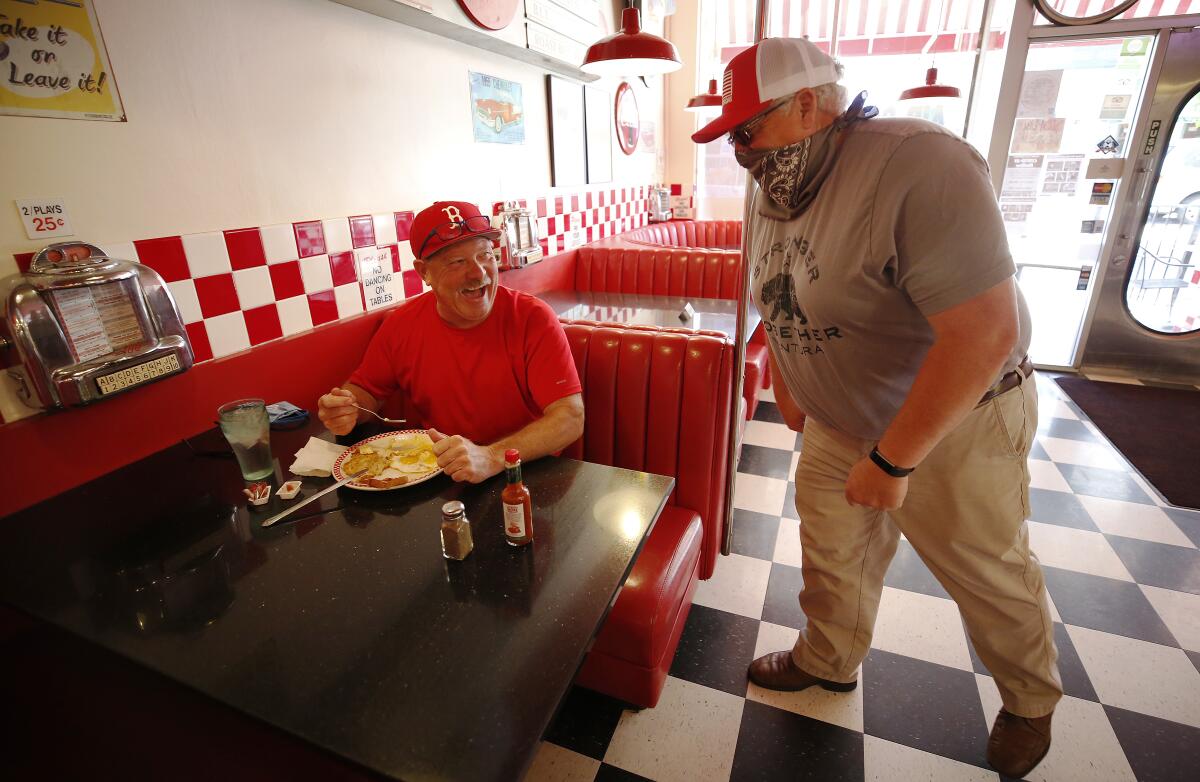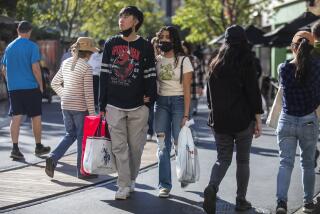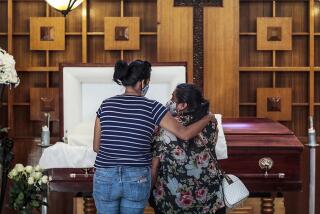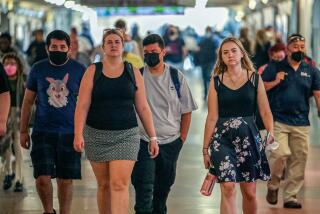As L.A. County deaths pass 2,000, a warning that ‘the virus is still out there waiting’

As large swaths of California began reopening shopping malls, restaurants and other businesses this week, the coronavirus threat in Los Angeles County remains high as the death toll surpassed 2,000 people on Thursday.
More than 40 of California’s 58 counties have now been approved to expand retail operations as their virus conditions improved, with more expected to reopen their economies in the coming days.
But officials expect the progress to be slower in Los Angeles County, which accounts for nearly 60% of the state’s total deaths and almost half of the more than 86,000 confirmed infections. The county’s death toll rose Thursday to 2,016, with more than 42,000 confirmed cases.
“This is a very sad milestone for us,” county Public Health Director Barbara Ferrer said.
“We’ve basically wiped out a decade worth of job creation in a month and a half,” an economist says. May’s unemployment figures will probably look even grimmer.
Los Angeles County Supervisor Hilda Solis said she hoped officials could ease stay-at-home restrictions soon but urged caution.
“I wish that we could speed things up,” she said. “The virus is still out there waiting for us to let our guard down.”
Despite the average daily death toll, which has remained at a stubborn plateau for weeks, there were new signs that even Los Angeles was beginning to turn the corner.
The coronavirus transmission rate in the nation’s most populous county, home to 56% of COVID-19 deaths in California, is now in its best position since the magnitude of the outbreak became clear in March.
At the start of the pandemic’s arrival in L.A., the transmission rate of the coronavirus was high; on average, every one person infected went on to infect more than three other people. Scientists call this rate of transmission the effective transmission number, or “R.”
But by late March, after the stay-at-home order was put into effect, the effective transmission number fell to 1, meaning that, on average, every person with COVID-19 infected one other person. That rate, if sustained, means that the number of people infected remains constant.
Dr. Christina Ghaly, director of health services for L.A. County, said a continuing downturn in the daily number of new confirmed cases suggested that the effective transmission number was now slightly under 1.
“If ‘R’ stays under 1, then the epidemic in Los Angeles County is expected to decrease over time,” Ghaly said.
“That is a good thing for all of us. As we work to reopen the economy and get people back to work and back to living their lives, we need to work together to avoid having transmission again increase,” she said.
Use of hospital beds by COVID-19 patients is also stable and slightly trending downward in L.A. County, Ghaly said.
It’s still possible, however, that Los Angeles County could run out of intensive care beds if disease transmission rates rise significantly. If more people start being infected as society reopens, officials won’t know it until two or four weeks later, the time it takes for those people to get so sick they need medical attention.
An L.A. County simulation has found that if the county can keep the disease transmission rate the same as it is now, by the start of December, just 9% of L.A. County residents will have contracted the coronavirus.
But if the effective transmission number were to rise to 1.5 — meaning each infected person gives the virus, on average, to 1.5 other people — 44% of county residents will have been infected by the start of December.
Overall, 52% of those who have died in Los Angeles County lived in an institutional setting. The vast majority were residents of skilled-nursing facilities.
Los Angeles County has begun to relax some of its coronavirus restrictions but doesn’t meet the state’s criteria for a wider reopening.
To the south, new concerns emerged in Orange County, which recorded 14 new coronavirus-related fatalities Thursday — the most in a single day since the pandemic began. Officials attributed the uptick to outbreaks in nursing homes.
The rise in deaths comes a day after the county reported 10 fatalities related to COVID-19. Of those who have died in the past two days, 18 were residents in skilled nursing facilities, Orange County Health Officer Dr. Nichole Quick said.
“We’ll have to watch that over the coming week to see if this is a trend or if it was just a couple of days of increase,” Quick said. “We hope it was just that.”
Orange County is hoping to reopen more of its economy but is still waiting for state approval.
“We believe we have met all the criteria,” Orange County Supervisor Michelle Steel said. “We submitted a draft plan and are currently in the process of meeting with the state to finalize our variance.”
Much of California has progressed to a point where officials feel it’s safe to lift more of the state’s stay-at-home order and allow more businesses to reopen.
The number of new coronavirus cases across the state declined from the previous week, and hospitalizations have dropped more than 15% from a peak six weeks ago, according to a Times analysis.
Most counties have received approval to progress more quickly through Phase 2 of the state’s reopening road map — meaning they can open restaurant dining rooms and more retail businesses for in-store shopping.
The list of counties that can ramp up their reopening efforts now includes San Diego — the state’s second-most populous — Kern, San Luis Obispo, Santa Barbara and Ventura.
Ventura County Executive Officer Mike Powers said he was “so happy for our county, businesses and employees,” adding that there’s still “a long way to go, but this is a major milestone.”
“COVID-19 has had devastating impacts on both community health and our economy,” he said. “We want businesses to be able to reopen, and we believe they can and will do so safely.”
Dr. Penny Borenstein, San Luis Obispo County’s health officer, said that before retail businesses can open their doors or restaurants can start offering dine-in service there, they must perform a risk assessment, train their workers to counteract the spread of the virus, and perform temperature checks on employees and, in some cases, patrons.
The county will inspect businesses that reopen to be sure they’re in compliance, she said.
She also asked tourists to stay out of San Luis Obispo County. While officials have performed “spot checks” with hotels to deter tourism, Borenstein said the county would cite visitors only in the case of “egregious violations.”
It’s unclear when Los Angeles County will begin a wider reopening.
But Supervisor Janice Hahn called on Gov. Gavin Newsom to allow all retail businesses across the state to open, provided they meet the same public health protocols — including limiting capacity, and requiring face coverings for employees and customers as well as physical distancing.
Doing so, she said Thursday, would help level the playing field between retailers that had to close because of coronavirus restrictions and larger ones such as Walmart, Costco and Target that have been allowed to stay open throughout the pandemic because they also serve as grocery stores and pharmacies.
Times staff writers Cindy Carcamo, Leila Miller and James Rainey contributed this report.
More to Read
Start your day right
Sign up for Essential California for news, features and recommendations from the L.A. Times and beyond in your inbox six days a week.
You may occasionally receive promotional content from the Los Angeles Times.










